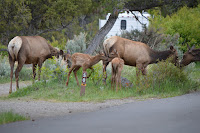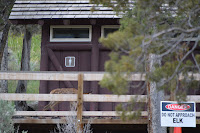*Critters we’ve seen on our
2013 trip so far: bison, pronghorn, elk,
white-tail deer, Uinta ground squirrel, coyote, snowshoe hare, grizzly bear,
moose, wolf, red fox, black bear, bighorn sheep
*Birds we’ve seen on our 2013
trip so far: osprey, pheasant, magpie, raven, Canada geese, mountain bluebird,
grouse, golden eagle, bald eagle, American avocet, sandhill crane, red-tailed hawk
[Click on any
photo to enlarge.]
 We’ve become quite accustomed to elk hanging out in the campground, but
one morning we had the pleasure of about a dozen bison including a couple of calves
enjoying the morning shade. They hung
around most of the morning,
We’ve become quite accustomed to elk hanging out in the campground, but
one morning we had the pleasure of about a dozen bison including a couple of calves
enjoying the morning shade. They hung
around most of the morning,
 and though we were working, Russ watched the office
for a few minutes while I ran to get our camera and get some shots. Eventually they started moseying through the
campground, grazing
and though we were working, Russ watched the office
for a few minutes while I ran to get our camera and get some shots. Eventually they started moseying through the
campground, grazing
 as they went, checking out the campsites, and making
themselves quite at home. We always tell
people….remember, the park belongs to the animals, and we are merely the
visitors.
as they went, checking out the campsites, and making
themselves quite at home. We always tell
people….remember, the park belongs to the animals, and we are merely the
visitors.
 As for the elk, they love to hang out in the campground mainly because there aren't many
predators. Now that it's calving
season, the cows feel fairly safe bringing their calves here and stashing them
among the sage or next to someone’s tent or a rock or even the restroom. And though most of the time you might not see
where the calf is stashed,
As for the elk, they love to hang out in the campground mainly because there aren't many
predators. Now that it's calving
season, the cows feel fairly safe bringing their calves here and stashing them
among the sage or next to someone’s tent or a rock or even the restroom. And though most of the time you might not see
where the calf is stashed,
 mama knows where it is and will charge at anyone
whom she feels is getting too close.
After all, to her we could be a predator of sorts. But this time of year
it’s so fun to see the young calves with their spotted coats hanging out,
learning the ways of life, and hopefully staying safe. Sometimes we even get lucky enough to see two
little ones playing together and chasing each other, under their moms’ watchful
eyes of course.
It's not only the animals who enjoying hanging out. Of course we humans enjoy do too. Sometimes, like these folks, it can be standing on a hill early on a spring evening
after a gentle rain under a beautiful rainbowed sky or maybe simply sitting
on the bank of the river as it roars by.
However you choose to hang, just enjoy.
mama knows where it is and will charge at anyone
whom she feels is getting too close.
After all, to her we could be a predator of sorts. But this time of year
it’s so fun to see the young calves with their spotted coats hanging out,
learning the ways of life, and hopefully staying safe. Sometimes we even get lucky enough to see two
little ones playing together and chasing each other, under their moms’ watchful
eyes of course.
It's not only the animals who enjoying hanging out. Of course we humans enjoy do too. Sometimes, like these folks, it can be standing on a hill early on a spring evening
after a gentle rain under a beautiful rainbowed sky or maybe simply sitting
on the bank of the river as it roars by.
However you choose to hang, just enjoy.

Yellowstone Tidbits:
Bison: male (bull) weighs up to 2,000 lbs., female (cow) up to 1,000 lbs., calves can run with the herd 2 - 3 hours after birth.
Elk: male (bull) weighs about 700 lbs., female (cow) about 500 lbs., and calf about 30 lbs. at birth.
Osprey: Eggs hatch in 4 - 5 weeks and the young can fly when 7 - 8 weeks old.
In the air an osprey will position a fish they are carrying so its head is pointed forward to reduce air resistance.
